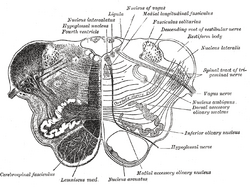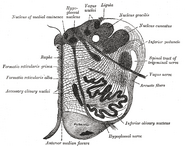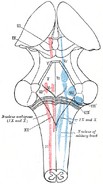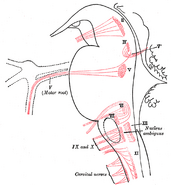Assessment |
Biopsychology |
Comparative |
Cognitive |
Developmental |
Language |
Individual differences |
Personality |
Philosophy |
Social |
Methods |
Statistics |
Clinical |
Educational |
Industrial |
Professional items |
World psychology |
Biological: Behavioural genetics · Evolutionary psychology · Neuroanatomy · Neurochemistry · Neuroendocrinology · Neuroscience · Psychoneuroimmunology · Physiological Psychology · Psychopharmacology (Index, Outline)
| Brain: Nucleus ambiguus | ||
|---|---|---|
| Transverse section of medulla oblongata below the middle of the olive. ("Nucleus ambiguus" labeled at center right.) | ||
| [[Image:|250px|center|]] | ||
| Latin | Nucleus ambiguus | |
| Gray's | subject #187 779 | |
| Part of | ||
| Components | ||
| Artery | ||
| Vein | ||
| BrainInfo/UW | hier-762 | |
| MeSH | [1] | |
The nucleus ambiguus (literally "ambiguous nucleus") is a region of histologically disparate cells located just dorsal (posterior) to the inferior olivary nucleus in the lateral portion of the upper (rostral) medulla. It receives upper motor neuron innervation directly via the corticobulbar tract.
This nucleus gives rise to the branchial efferent motor fibers of the vagus nerve (CN X) terminating in the laryngeal, pharyngeal muscles, and musculus uvulae[citation needed]; as well as to the efferent motor fibers of the glossopharyngeal nerve (CN IX) terminating in the stylopharyngeus muscle.
Areas supplied[]
The muscles supplied by the vagus (included with this is the cranial part of the accessory nerve), such as levator veli palatini, are also necessary to swallow properly through integration by the nucleus of the solitary tract. The vagus also supplies the upper part of the esophagus, and other parts of the pharynx and larynx.
As well as motor neurons, the nucleus ambiguus in its "external formation" contains cholinergic preganglionic parasympathetic neurons for the heart.[1] These neurons are cardioinhibitory.[2] This cardioinhibitory effect is one of the means by which quick changes in blood pressure are achieved by the central nervous system (the primary means being changes in sympathetic nervous system activity, which constricts arterioles and makes the heart pump faster and harder). That is, through integrated and antagonistic system with sympathetic outflow from the vasomotor center of the brainstem, the parasympathetic outflow arising from the nucleus ambiguus and dorsal motor nucleus of the vagus nerve acts to decrease cardiac activity in response to fast increases in blood pressure. The external formation of the nucleus ambiguus also sends bronchoconstrictor fibers to the bronchopulmonary system, which can produce reflexive decreases in pulmonary bronchial airflow. The pathophysiologic relevance of this system, which may act in concert with the cardioinhibitory system, is poorly understood, but likely plays a role in bronchospastic diseases like COPD/emphysema (in which inhaled anticholinergic medications such as Spiriva/tiotropium or ipratropium are standard-of-care treatment) and asthma, particularly for exercise-related asthma exacerbations, which may have a component of autonomic dysregulation.
Additional images[]
References[]
- ↑ Role of the nucleus ambiguus in the regulation of heart rate and arterial pressure. BH Machado and MJ Brody. http://hyper.ahajournals.org/cgi/content/abstract/11/6/602
- ↑ Localization of vagal cardioinhibitory preganglionic neurons with rat brain stem. Nosaka S et al. http://www3.interscience.wiley.com/journal/109685993/abstract
External links[]
- Medical Neurosciences discuss the nucleus ambiguus.
- GPnotebook -1664090053
I-IV: olfactory - optic - oculomotor - trochlear
V: trigeminal: trigeminal ganglion
V1: ophthalmic: lacrimal - frontal (supratrochlear, supraorbital) - nasociliary (long root of ciliary, long ciliary, infratrochlear, posterior ethmoidal, anterior ethmoidal) - ciliary ganglion (short ciliary)
V2: maxillary: middle meningeal - in the pterygopalatine fossa (zygomatic, zygomaticotemporal, zygomaticofacial, sphenopalatine, posterior superior alveolar)
in the infraorbital canal/infraorbital nerve (middle superior alveolar, anterior superior alveolar)
on the face (inferior palpebral, external nasal, superior labial, infraorbital plexus) - pterygopalatine ganglion (deep petrosal, nerve of pterygoid canal)
branches of distribution (palatine, nasopalatine, pharyngeal)
V3: mandibular: nervus spinosus - medial pterygoid - anterior (masseteric, deep temporal, buccal, lateral pterygoid)
posterior (auriculotemporal, lingual, inferior alveolar, mylohyoid, mental) - otic ganglion - submandibular ganglion
VI: abducens
VII: facial: nervus intermedius - geniculate - inside facial canal (greater petrosal, nerve to the stapedius, chorda tympani)
at exit from stylomastoid foramen (posterior auricular, digastric - stylohyoid)
on face (temporal, zygomatic, buccal, mandibular, cervical)
VIII: vestibulocochlear: cochlear (striae medullares, lateral lemniscus) - vestibular
IX: glossopharyngeal: fasciculus solitarius - nucleus ambiguus - ganglia (superior, petrous) - tympanic - carotid sinus
X: vagus: ganglia (jugular, nodose) - Alderman's nerve - in the neck (pharyngeal branch, superior laryngeal ext and int, recurrent laryngeal)
in the thorax (pulmonary branches, esophageal plexus) - in the abdomen (gastric plexuses, celiac plexus, gastric plexus)
XI: accessory XII: hypoglossal
| This page uses Creative Commons Licensed content from Wikipedia (view authors). |




